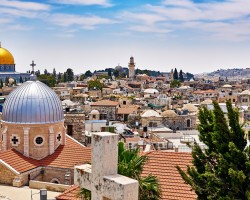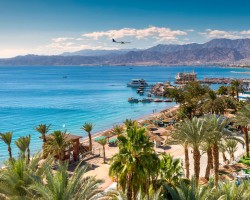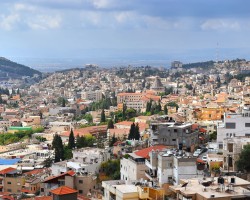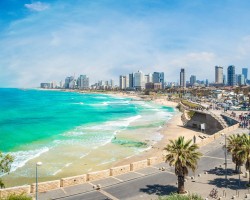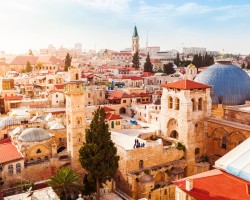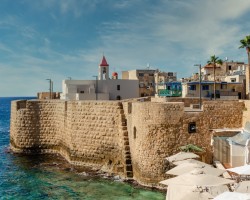Best time to go to Israel for a perfect weather and where to go?
When is the best time to go to Israel?
Although a trip is possible all year round, the best time to visit Israel and the Palestinian territories is spring, from April to June, as well as autumn, from September to November. Indeed, depending on the regions, temperatures can be scorching in summer and rain can be expected during winter.
Your choice of holiday dates will therefore mainly depend on what you want to do on the spot:
- Enthusiasts of hiking and nature will prefer spring, from March to May, and the month of September. It is the ideal time to walk in good conditions: the weather is nice and not too hot.
- If you want to do cultural visits, just avoid the summer months, especially July and August.
- For scuba diving, whether in the Red Sea or along the Mediterranean coast, visibility is at its maximum in March, April, November, and December. From May to October, the water is much warmer, but a bit more cloudy, which can be perfect if you are traveling with children.
- To enjoy a sunny holiday and make the most of the beautiful Israeli beaches, go from early May to late October along the Mediterranean and from March to June, as well as from September to November in the Red Sea resorts.
When is the best time to visit Israel to avoid crowds? The high tourist season is in April-May and from July to December, with the peak of visitors in August. This is also the month when plane tickets are the most expensive and hotels are crowded, especially on the coasts. June is therefore perfect to enjoy all the country's assets! From January to March, it is the low season: visitors are few and you can have a quiet stay to recharge your batteries.
What to pack for a trip to Israel (and Palestine)? From May to November, take light clothes and of course your swimsuit! However, it is important to opt for covering clothes and avoid shorts, low-cut tops, and short skirts, unless you plan to spend your days at the beach. In some holy places, you will have to take off your shoes, so take easy-to-remove and put back on shoes. Regardless of the season, take a sweater: air-conditioned spaces are common and evenings can be cool. Also, remember to protect yourself from the sun with a hat or cap, sunglasses, and sunscreen.
Where and when to go based on the weather?
Coastal Zone
Tel Aviv, Haifa, Netanya...
East
Jerusalem, Bet Shemesh, Modiin Ilit...
North
Nazareth, Tiberias, Nahariya...
Palestine (Palestinian territories)
Nablus, Ramallah, Gaza...
South
Eilat, Beersheba, Mitzpe Ramon...
To get all the information about the climate and weather in Israel for a specific month, click on the corresponding link below:
Israel in january Israel in february Israel in march Israel in april Israel in may Israel in june Israel in july Israel in august Israel in september Israel in october Israel in november Israel in december
Best time to travel to Israel by cities
Climate and Weather in Israel
Neighbor to Egypt, Jordan, Syria, and Lebanon, Israel is a long country measuring approximately 470 km from north to south, and 135 km at its widest point. It has three coastlines: the Mediterranean Sea to the northwest, the Dead Sea to the east, and a narrow strip of land along the Red Sea in the far south.
The climate in Israel (and Palestine) is characterized by variations depending on the regions:
- The Mediterranean climate with hot summers is predominant, covering 77% of the territory, especially in the capital, Jerusalem, in the northern part, and along the Mediterranean coast.
- A semi-arid steppe climate, dry and hot, is found in the south, such as around Beer-Sheva.
- An arid desert climate, hot and dry, prevails in the far south, in the Eilat region.
Generally, the weather in Israel (and Palestine) experiences a significant amount of sunshine, and only the months from November to April may have a few rainy days, especially along the Mediterranean, in the north, and in the center of the country.

Climate of Israel
In the north and along the coastal area, from Tel Aviv to Haifa, winters are very mild. From December to March, temperatures range between 18 and 22°C (72°F) during the day, and slightly lower at night. However, showers are possible and January can be quite rainy depending on the year. April and November are the short transitional seasons with averages between 25 and 27°C (81°F) . From May to October, it's summer. The mercury rises between 30 and 36°C (97°F) , with July and August being the hottest months. During this period, it hardly ever rains and the sea water is at 28°C (83°F) !
In the east of Israel, the climate is quite similar, but it gets even hotter during the summer season, with highs around 36°C (97°F) in July-August and heat waves often reaching close to 40°C (104°F) . Summer arrives a bit earlier, starting in early April, with daytime averages around 28°C (83°F) .
In the south of Israel, the arid climate leads to extreme temperatures during the summer. From June to September, temperatures reach between 37 and 39°C (103°F) in the shade in Eilat, while in spring and autumn, the thermometer hovers around 30°C (86°F) . In winter, from December to March, temperatures range between 21 and 25°C (77°F) and some showers may occur. It is still possible to swim, for example, the Red Sea is at 24°C (76°F) in December. The region also includes mountainous areas where the weather is cooler. For instance, in Yotvata, the average temperature is 16°C (61°F) in January and in Ashdod, expect 31°C (88°F) in July-August.
Climate of Palestine
The Palestinian Territories are divided into two zones with different climates:
- Gaza Strip is located on the Egyptian border and overlooks the Mediterranean Sea. Its climate is semi-arid steppe, dry and hot.
- West Bank is located on the border with Jordan and overlooks the Dead Sea. The climate is predominantly Mediterranean with hot summers, except along the Jordan Valley where tropical notes can be found.
Like in Israel, winters are generally mild, with temperatures between 19 and 24°C (76°F) from December to March, but the atmosphere can quickly be cooled by the wind, especially if you are in elevated areas.
Summer lasts from April to October and temperatures can be stifling, especially in the Jericho region which experiences heat peaks around 37°C (99°F) throughout the season. In Nablus, it is less hot, with averages not exceeding 32°C (90°F) .
Temperatures and rainfall in Israel
On these 3 graphs, we present the evolution of temperatures of Israel and month-by-month rainfall for the cities of Jerusalem, Eilat, Nazareth, Tel Aviv and Beersheba, as well as the month-by-month sea temperature for coastal cities.
Peak visitor numbers and tourist seasons in Israel
Find out when Israel has its high tourist season (the period when the influx of tourists is highest) and off-peak tourist season using our data and figures.
Tourist seasons in Israel
The months with low numbers of tourists are: January, February, March and June. The number of visitors to Israel is high in: April, May, July, August, September, October, November and December.
- Very low season in Israel: January, February and March.
- Low season in Israel: June.
- High season in Israel: April, May, July, September and November.
- Peak season in Israel: August, October and December.
Figure: Visitor index for Israel month by month
Average price for flights to Israel
A return flight between New York City and Tel Aviv is generally cheaper if you go in january ($ 835 on average): this is the best time for travellers on a tight budget. In contrast, you may end up paying $ 384 more for your airline ticket to Tel Aviv if you go in july.
Where to go in Israel?
This table allows you to see the maximum temperature for each city and our opinion on the weather month by month (see colour legend below the table).
| Cities | jan. | feb. | mar. | apr. | may | jun. | jul. | aug. | sep. | oct. | nov. | dec. |
| Jerusalem | 61°F | 63°F | 68°F | 77°F | 85°F | 88°F | 92°F | 92°F | 88°F | 83°F | 74°F | 65°F |
| Eilat | 68°F | 72°F | 77°F | 86°F | 94°F | 99°F | 103°F | 103°F | 99°F | 90°F | 79°F | 72°F |
| Nazareth | 65°F | 65°F | 68°F | 76°F | 83°F | 88°F | 92°F | 92°F | 90°F | 88°F | 81°F | 72°F |
| Tel Aviv | 65°F | 67°F | 70°F | 76°F | 81°F | 85°F | 88°F | 90°F | 88°F | 85°F | 77°F | 70°F |
| Beersheba | 65°F | 67°F | 72°F | 79°F | 86°F | 92°F | 94°F | 95°F | 92°F | 86°F | 76°F | 68°F |
| Bet Shemesh | 67°F | 70°F | 74°F | 83°F | 88°F | 94°F | 97°F | 97°F | 95°F | 88°F | 79°F | 70°F |
| Gaza | 65°F | 67°F | 70°F | 74°F | 81°F | 85°F | 86°F | 88°F | 86°F | 83°F | 76°F | 68°F |
| Haifa | 63°F | 67°F | 70°F | 77°F | 86°F | 90°F | 94°F | 95°F | 92°F | 86°F | 77°F | 67°F |
| Mitzpe Ramon | 63°F | 67°F | 74°F | 83°F | 90°F | 95°F | 99°F | 97°F | 94°F | 86°F | 76°F | 67°F |
| Modiin Ilit | 67°F | 68°F | 70°F | 77°F | 85°F | 88°F | 92°F | 92°F | 90°F | 86°F | 79°F | 70°F |
| Nablus | 63°F | 67°F | 70°F | 76°F | 83°F | 86°F | 88°F | 90°F | 88°F | 85°F | 76°F | 67°F |
| Nahariya | 65°F | 65°F | 68°F | 72°F | 79°F | 83°F | 86°F | 88°F | 86°F | 83°F | 76°F | 68°F |
| Netanya | 65°F | 67°F | 70°F | 76°F | 81°F | 86°F | 90°F | 90°F | 88°F | 85°F | 77°F | 68°F |
| Ramallah | 61°F | 65°F | 70°F | 77°F | 86°F | 90°F | 94°F | 94°F | 92°F | 85°F | 74°F | 65°F |
| Tiberias | 59°F | 63°F | 68°F | 77°F | 85°F | 90°F | 94°F | 95°F | 92°F | 85°F | 74°F | 65°F |
| Acre | 65°F | 65°F | 68°F | 72°F | 79°F | 83°F | 86°F | 88°F | 86°F | 83°F | 76°F | 68°F |
| Afula | 63°F | 67°F | 70°F | 77°F | 86°F | 90°F | 94°F | 95°F | 92°F | 86°F | 77°F | 67°F |
| Atlit | 63°F | 65°F | 70°F | 76°F | 83°F | 86°F | 88°F | 90°F | 88°F | 85°F | 76°F | 67°F |
| Be'er Ora | 65°F | 70°F | 77°F | 85°F | 94°F | 97°F | 101°F | 101°F | 95°F | 88°F | 77°F | 68°F |
| Bethlehem | 61°F | 65°F | 70°F | 77°F | 86°F | 90°F | 94°F | 94°F | 92°F | 85°F | 74°F | 65°F |
Legend:
perfect weather
good weather
tolerable weather
About Israel
What can I do in Israel?
Beaches / swimming
Nature and countryside
Culture and heritage
Sports
Family travel
Crafts / shopping
Gastronomy
Nightlife
Is this weather information for Israel reliable?
Climate data for Israel has been gathered every day since January 2009. The analysis of these meteorological data for Israel allows us to determine the average for each month in Jerusalem, Eilat, Nazareth, Tel Aviv, Beersheba, Bet Shemesh, Gaza, Haifa, and 38 other cities.
So yes: this data is reliable except in cases of temporary climate disruption in the region.

